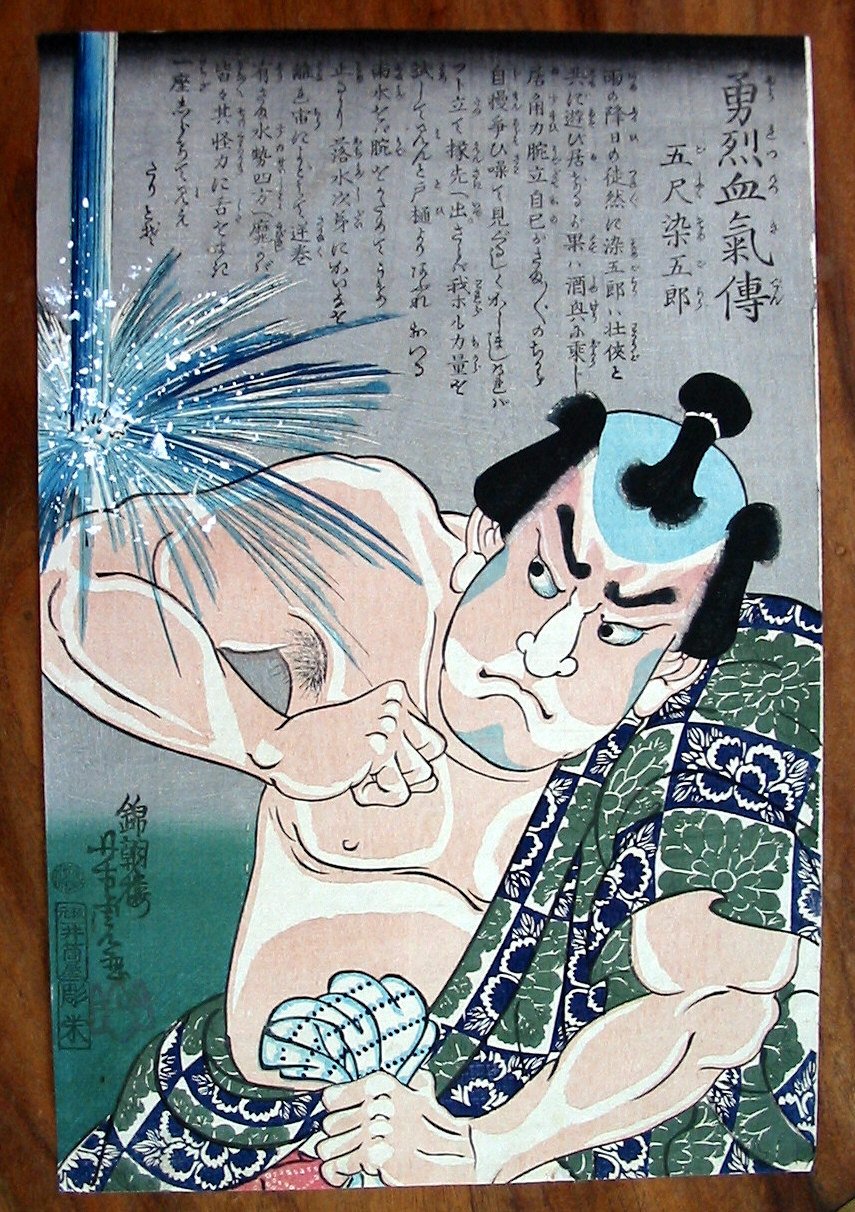
JAPANESE PRINTS
A MILLION QUESTIONS
TWO MILLION MYSTERIES
Ukiyo-e Prints浮世絵版画 |
| Port Townsend, Washington |
| UTAGAWA YOSHITORA |
| 歌川芳虎 |
| うたがわよしとら |
| fl. ca. 1850-80 |
| Subject: Goshaku Somegorō |
| 五尺染五郎 |
| ごしゃく.そめごろう |
| Size: 14 ¼” x 9 5/8” |
| Date: 1866 |
| Keiō 2 |
| 慶応2 |
| Publisher: Hironoya Shinzō |
| 平野屋新蔵 |
| ひろのやしんぞう |
| SOLD! |

|
LINEAR A STRING THEORY & THE YETI |
|
|
|
At the beginning of the 20th century Sir Arthur Evans excavated the stunning site at the palace of Knossos on Crete. There he found a number of tablets inscribed with two different forms of script. These have been named Linear A, the earlier type, and Linear B. Despite all of his efforts Evans was unable to make much headway in deciphering them. It wasn't until 1952 that a trained architect with an interest in archeology, Michael Ventris, succeeded in unscrambling Linear B. Linear A remains an enigma to this day.
Currently astrophysicists are looking for the single concept which will draw all things neatly together in a nice tidy bundle. The strong force, the weak force, etc. Some great minds are searching for a practical application to the so-called "string theory". Other scientists swear that this area of study falls more under the heading of philosophy --- and more exactly within the parameters of metaphysics --- than as true science. Some of them even consider it akin to conjectural grasping at straws in a strong wind. A very strong wind. A stellar wind.
And then there is the yeti. What can I say? Nothing. Prove it.
That brings me to the topic I am really trying to get at: Who in the heck is Goshaku Somegoro? We know the name and we know a few frustratingly obscure references to this figure, but beyond that we know nada.* What does this tell us? That the amount of hard facts to be found for a majority of Japanese topics is pitifully inadequate. Even a reasonably good search on the Internet in Japanese produces no workable results.
Why am I telling you this? Because I know that the information is out there somewhere. Perhaps it is locked away in original source material to be found only in Japan, but it is there. I can feel it. These are the gaps which need filling. How many more studies do we really need on Hiroshige landscapes, post-modernist interpretations of Japanese erotica or iterations of Kuniyoshi's Suikoden series(es) which add nothing substantially new? Someone needs to get out there and answer the genuine iconographic issues raised by the mass of Japanese prints which we have so readily at hand. No question should go unanswered. Of course, prints are wonderful to look at, but they are so much more. They are telling us things that we can't possibly comprehend without a greater knowledge of the milieu they came out of. Don't let me down. I want the answers --- or some of them before I die.
Got to go now. They won't hold my room at the inn in Brigadoon forever! |
|
|
|
*This morning --- today is November 11, 2004 --- I received an e-mail from E who is one our correspondents and contributors. He wrote:
"Hi Jerry, love the Yoshitora with the armpit hair! I have just spent a somewhat unproductive hour trying to work out who the hell Goshaku Somegoro was. A google search led me back to your site where he is shown with a lightning tattoo in your discussion on lightning in a print by Kunikazu and to a depiction of him by Kuniyoshi in his series Robinson S40.3 where he is playing a shakuhachi. The Kabuki21 site lead me to the entry on Ichikawa Yaozu II where he played the role of Goshaku Somegoro in May 1766 in the play Yaoya Oshichi Koi no Edozome. The New Kabuki Handbook lists this under Oshichi Kichisa Mono where the story seems to lack any mention of Somegoro or of waterfalls. The names do not feature in Edmunds or Joly. Do you have any leads?"
He told me much more than I already knew. In fact, I hadn't even bothered with the name of the character yet, but was going to get around to it. E saved me a lot of work, but he also spurred me to write my accusatory comments which are stated in the section above this one.
If anyone out there
knows anything more about Goshaku Somegoro E. and I would appreciate your
input. |
 HOME
HOME